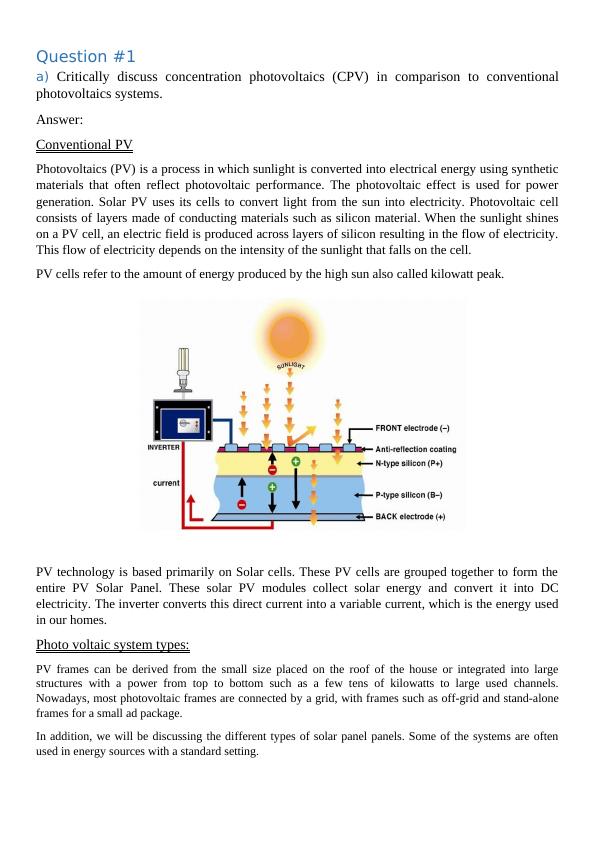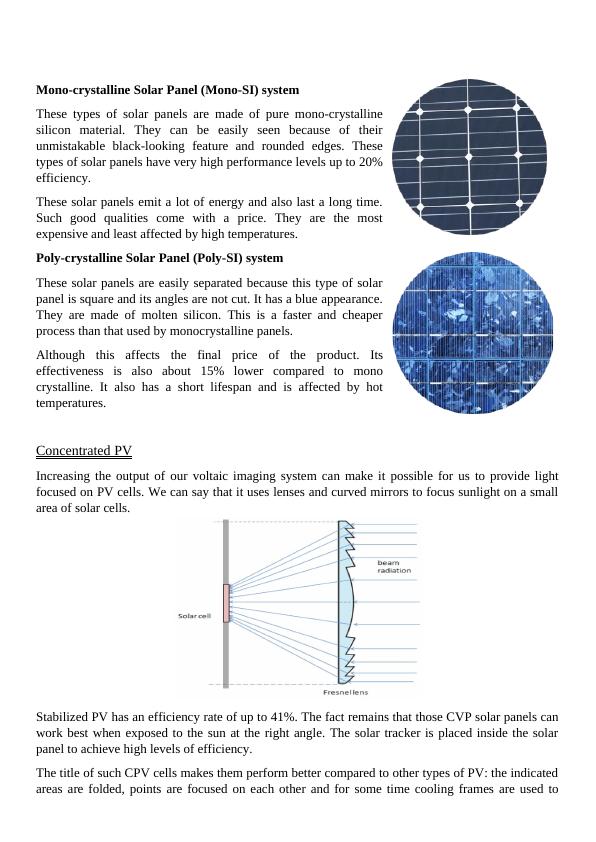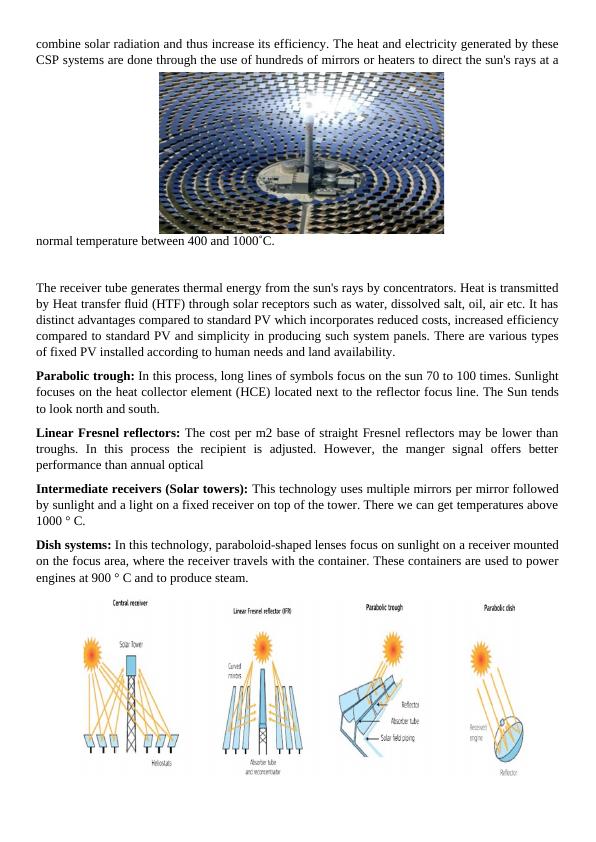Ask a question from expert
conventional photovoltaics systems Assignment PDF
18 Pages3480 Words361 Views
Added on 2021-05-17
conventional photovoltaics systems Assignment PDF
Added on 2021-05-17
BookmarkShareRelated Documents
Question #1 a) Critically discuss concentration photovoltaics (CPV) in comparison to conventionalphotovoltaics systems. Answer:Conventional PVPhotovoltaics (PV) is a process in which sunlight is converted into electrical energy using syntheticmaterials that often reflect photovoltaic performance. The photovoltaic effect is used for powergeneration. Solar PV uses its cells to convert light from the sun into electricity. Photovoltaic cellconsists of layers made of conducting materials such as silicon material. When the sunlight shineson a PV cell, an electric field is produced across layers of silicon resulting in the flow of electricity.This flow of electricity depends on the intensity of the sunlight that falls on the cell.PV cells refer to the amount of energy produced by the high sun also called kilowatt peak. PV technology is based primarily on Solar cells. These PV cells are grouped together to form theentire PV Solar Panel. These solar PV modules collect solar energy and convert it into DCelectricity. The inverter converts this direct current into a variable current, which is the energy usedin our homes.Photo voltaic system types:PV frames can be derived from the small size placed on the roof of the house or integrated into largestructures with a power from top to bottom such as a few tens of kilowatts to large used channels.Nowadays, most photovoltaic frames are connected by a grid, with frames such as off-grid and stand-aloneframes for a small ad package. In addition, we will be discussing the different types of solar panel panels. Some of the systems are oftenused in energy sources with a standard setting.

Mono-crystalline Solar Panel (Mono-SI) systemThese types of solar panels are made of pure mono-crystallinesilicon material. They can be easily seen because of theirunmistakable black-looking feature and rounded edges. Thesetypes of solar panels have very high performance levels up to 20%efficiency.These solar panels emit a lot of energy and also last a long time.Such good qualities come with a price. They are the mostexpensive and least affected by high temperatures.Poly-crystalline Solar Panel (Poly-SI) systemThese solar panels are easily separated because this type of solarpanel is square and its angles are not cut. It has a blue appearance.They are made of molten silicon. This is a faster and cheaperprocess than that used by monocrystalline panels.Although this affects the final price of the product. Itseffectiveness is also about 15% lower compared to monocrystalline. It also has a short lifespan and is affected by hottemperatures.Concentrated PVIncreasing the output of our voltaic imaging system can make it possible for us to provide lightfocused on PV cells. We can say that it uses lenses and curved mirrors to focus sunlight on a smallarea of solar cells.Stabilized PV has an efficiency rate of up to 41%. The fact remains that those CVP solar panels canwork best when exposed to the sun at the right angle. The solar tracker is placed inside the solarpanel to achieve high levels of efficiency.The title of such CPV cells makes them perform better compared to other types of PV: the indicatedareas are folded, points are focused on each other and for some time cooling frames are used to

combine solar radiation and thus increase its efficiency. The heat and electricity generated by theseCSP systems are done through the use of hundreds of mirrors or heaters to direct the sun's rays at anormal temperature between 400 and 1000 ̊C.The receiver tube generates thermal energy from the sun's rays by concentrators. Heat is transmittedby Heat transfer fluid (HTF) through solar receptors such as water, dissolved salt, oil, air etc. It hasdistinct advantages compared to standard PV which incorporates reduced costs, increased efficiencycompared to standard PV and simplicity in producing such system panels. There are various typesof fixed PV installed according to human needs and land availability. Parabolic trough:In this process, long lines of symbols focus on the sun 70 to 100 times. Sunlightfocuses on the heat collector element (HCE) located next to the reflector focus line. The Sun tendsto look north and south.Linear Fresnel reflectors: The cost per m2 base of straight Fresnel reflectors may be lower thantroughs. In this process the recipient is adjusted. However, the manger signal offers betterperformance than annual opticalIntermediate receivers (Solar towers): This technology uses multiple mirrors per mirror followedby sunlight and a light on a fixed receiver on top of the tower. There we can get temperatures above1000 ° C.Dish systems: In this technology, paraboloid-shaped lenses focus on sunlight on a receiver mountedon the focus area, where the receiver travels with the container. These containers are used to powerengines at 900 ° C and to produce steam.

Question #1 b)An industrial load consists of a synchronous motor of 100 metric h.p. induction motors aggregating 200 metric h.p., 0·707 power factor lagging and 82%efficiency lighting load aggregating 30 kW.The tariff is £100 per annum per kVA maximum demand plus £0.11 per kWh. Find theannual saving in cost if the synchronous motor operates at 93% efficiency and 0·8 p.f.leading, instead of 93% efficiency and 0·8 p.f. lagging.Solution.The annual power bill will be calculated under two conditions,(a) when synchronous motor runs with lagging p.f. (b) when synchronous motor runs with a leading p.f. (A) When the synchronous motor runs at the power factor 0.8 lagging: AnnualkVAdemandcharges=£100×374.4=£37,440Energyconsumedperyear=(288.4×8760)=25,26384kWhAnnualenergycharges=£0.11×25,26384=£277902Totalannualbill=£(37,440+277902)=£315342(B) When the synchronous motor runs at the power factor 0.8 leading.The synchronous motor is running at leading power factor of 0.8 (instead of 0.8 p.f. lagging), sotherefore it will take 59.25 leading reactive power kvar. The lagging kVAR which is taken bythe ac induction motors are the same as before e.g., 179.4.

End of preview
Want to access all the pages? Upload your documents or become a member.
Related Documents
(PDF) Solar Energy and Photovoltaic Systemslg...
|44
|10933
|150
Techno-Economic Analysis Of Solar Thermal Power Plantslg...
|14
|3059
|10
Techno-Economic Analysis Of Solar Thermal Power Plants In Omanlg...
|12
|3022
|10
Photovoltaic Solar Power System Assignment 2022lg...
|21
|3747
|135
New Technology Used in Photovoltaic Cellslg...
|7
|1708
|68
1. SOLAR PHOTO-VOLTAIC ENERGY By Name. Course Instructolg...
|11
|1910
|269